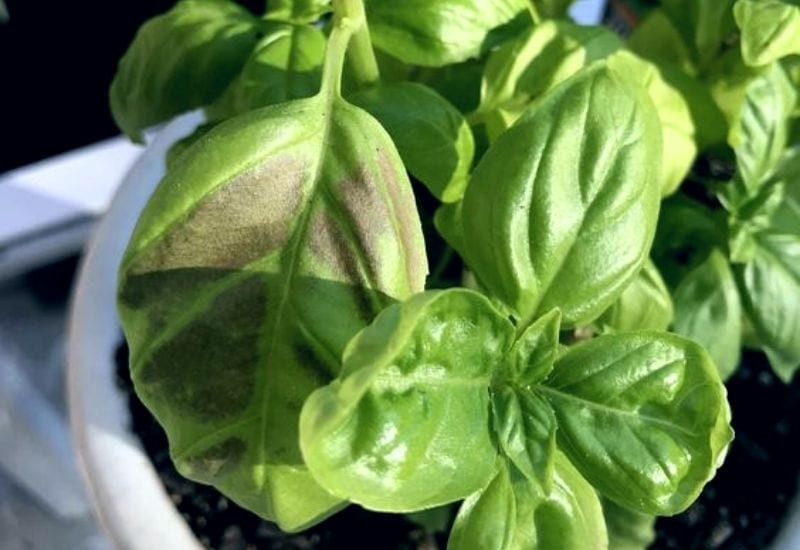
If you have ever grown basil in your garden, you might have noticed that it is not always a perfect green herb. If you’re noticing dead looking brown spots on your basil leaves, it’s a warning sign that something needs to change with your care regimen.
Brown spots on basil leaves often appear as a result of temperature swings, frost damage, sunburn, nutrient deficiencies, pest damage, or fungal infections.
Getting to the root of the issue takes a bit of observation, but rest assured that you can revitalize your basil in no time.
Here’s a few reasons why your basil has brown spots, how to treat these browning basil and how to prevent it from happening in the first place.
Can You Eat Brown Basil Leaves?
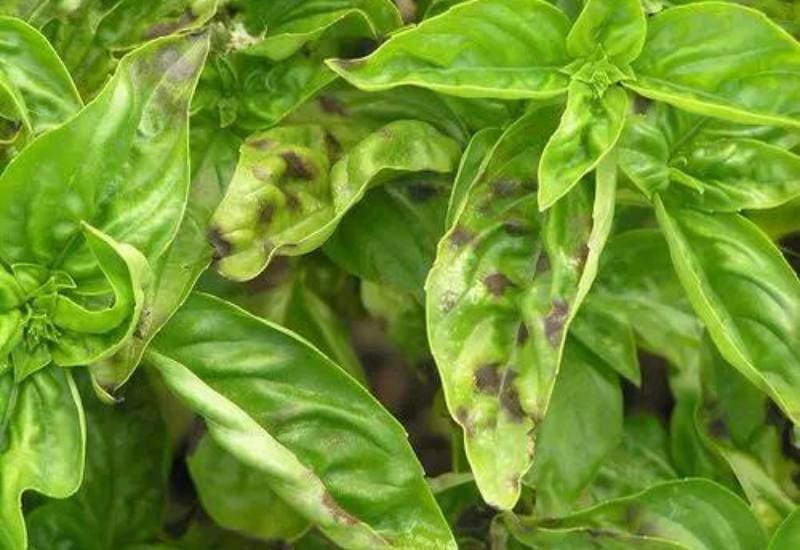
Basil can be found growing in gardens around the world. This fragrant herbal delight comes in a wide range of colors and varieties, and is ubiquitous in Italian, Mediterranean, Southeast Asian, and Indian cuisine.
Whether sprinkled on a Margherita pizza or blended in a pesto, brown spots on basil typically aren’t a huge deal in regards to flavor.
As long as the leaves are not diseased or sprayed with any pesticides, basil with brown spots is perfectly safe to eat.
However, browning basil leaves definitely aren’t aesthetically pleasing and may indicate a deeper issue in your herb garden.
Here’s Why Your Basil Has Brown Spots on Its Leaves
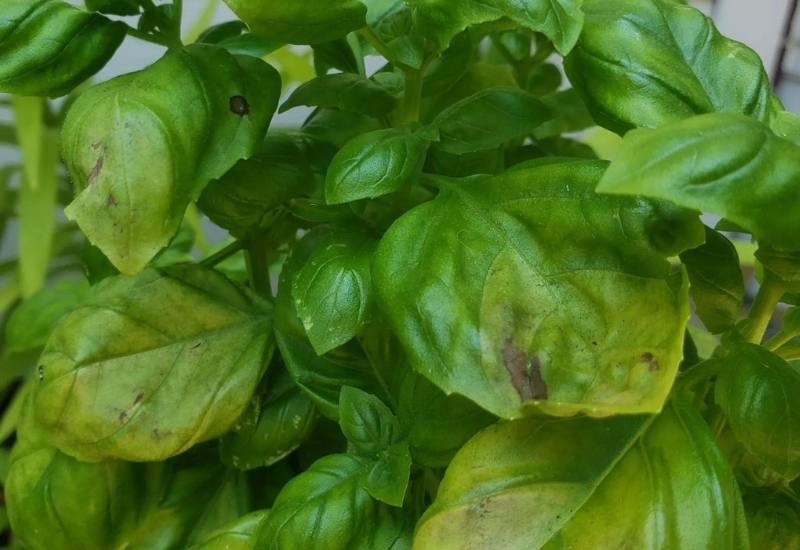
Brown or black spots on basil leaves is typically a sign of a pathogen, cold damage, pest damage, or a plant nutrition issue. You can also cause basil to turn brown by overhandling it at the time of harvest.
The excess moisture from your hands or storage container can cause premature browning and wilting that reduces the storage time of basil in the fridge.
Figuring out the cause of your plant’s damage requires a little bit of investigation. You can begin by looking for signs of disease and use a process of elimination to figure out if it is a pathogen, pest, or environmental problem.
Diseases that Cause Basil Browning
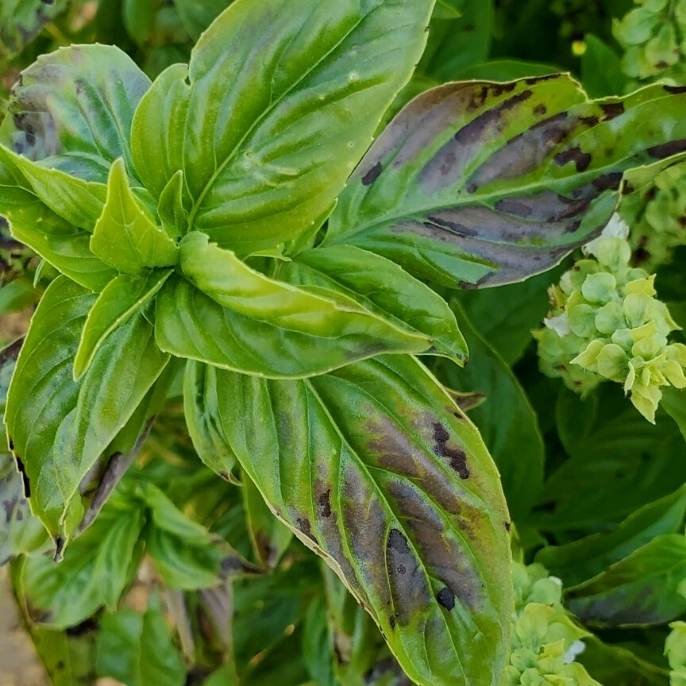
Basil thrives best in warm, dry areas with plenty of circulation. An excess amount of humidity or moisture that stays sitting on the leaves can cause a variety of different diseases from fungal or bacterial pathogens.
1: Bacterial Leaf Spot
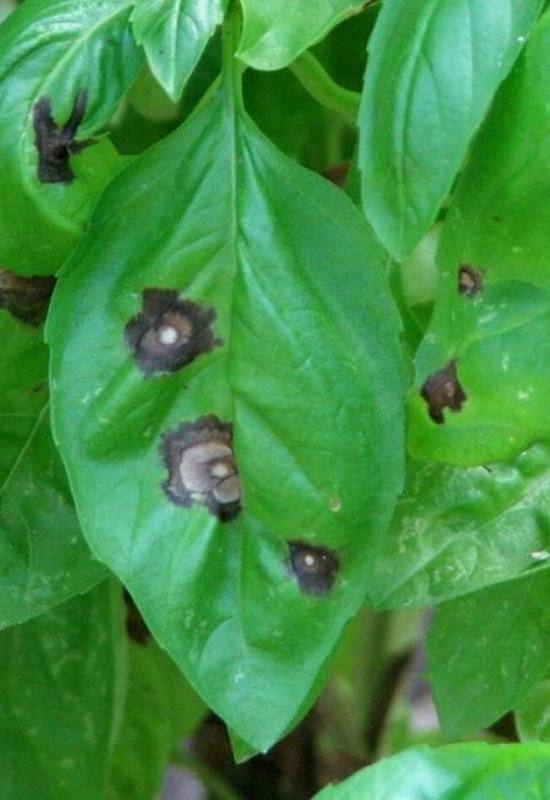
If the leaves appear to have water-soaked brown and black areas on the leaves and stems, you probably have an infection of Bacterial Leaf Spot.
The leaf spots will appear irregular or angular and separated by small veins. The Pseudomonas cichorii bacteria often arrives from contaminated transplants or seeds. It favors humid conditions and splashing water from overhead irrigation.
Basil plants with signs of Bacterial Leaf Spot should be removed and disposed of. A diluted neem solution spray may help prevent infection of other plants,
but it is far easier to use preventative methods for future basil plants than to try to save the plants you have.
Basic sanitation practices in the garden have been shown to keep Bacterial Leaf Spot at bay. Use drip irrigation or soaker hoses so that water does not splash onto basil leaves.
Maintain proper spacing and air circulation. Basil crop residue should never be left in the garden or greenhouse to overwinter.
2: Fusarium Wilt
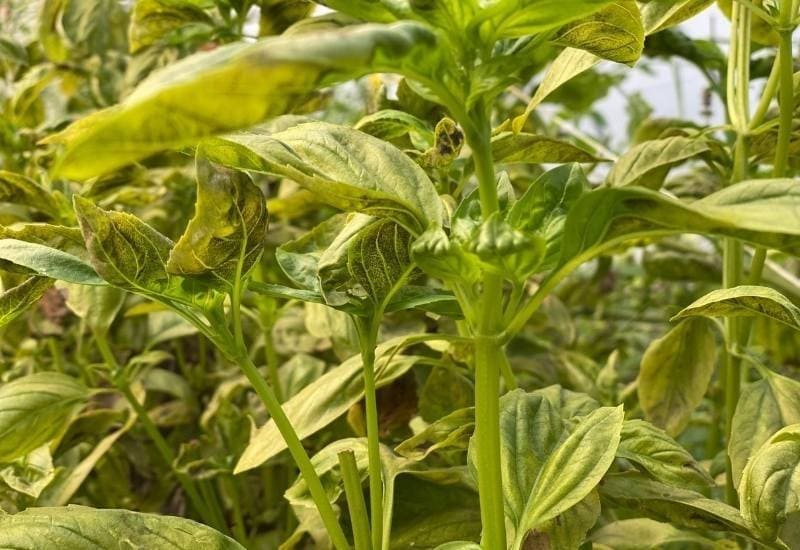
If your basil appears stunted with brown spots or streaks on the stem, wilted and yellowing leaves, or leaf drop, you may be dealing with a fungal disease called Fusarium.
This is the most common basil disease and sweet basil varieties like ‘Genovese’ are often the most susceptible.
The fungus can be spread from nearby plants, the soil, or the seeds from infected basil plants.
It favors wet, warm conditions and high amounts of ammonium nitrates from synthetic fertilizer. This is why it’s best to use slow-release organic fertilizers and grown basil in a well-drained soil.
Unfortunately, there is no known cure for Fusarium wilt. Infected plants should be removed as soon as possible and thrown away because airborne spores can be blown or splash onto nearby plants.
The Fusarium pathogen can also survive in the soil, so you should avoid planting basil in that area for at least 2 years.
Another great preventative method is simply purchasing disease-free basil seeds and varieties that have been bred for Fusarium resistance. Maintain plenty of air flow and circulation around basil plantings.
3: Downy Mildew
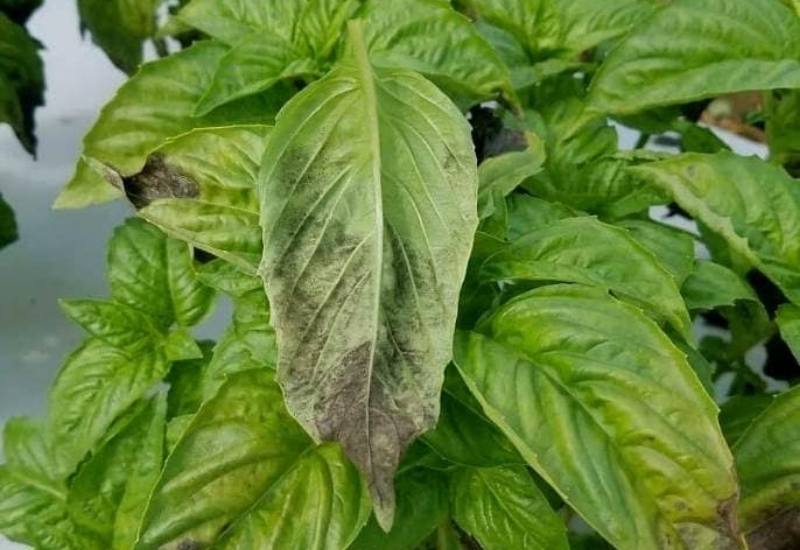
Another pathogen that favors warmth and high humidity, Pernospora belbahrii causes Downy Mildew in basil. It is especially common in the Northeast region of the U.S.
The key symptom is yellowing and browning that begins from the middle vein and spreads outward to cover the leaf.
As it spreads, you may notice a thin fuzzy purple or gray texture on the underside of leaves, which is the reproductive organ of this pathogen called sporangia.
Spores can spread very quickly through the wind, so it is important to remove diseased leaves or plants as soon as possible.
If the relative humidity stays high and the disease progresses, these lesions and spots will begin to turn brown.
The primary treatment method is an organic fungicide like neem oil or a hydrogen peroxide spray (¾ cup of 3% peroxide per gallon of water applied for 3-5 consecutive mornings) and baking soda application (2 tbsp. Baking soda per gallon of water sprayed directly on the plant for 1-3 days).
Preventative methods like increasing space between plants, using drip irrigation or soaker hoses, maintaining sanitization in the garden (removing crop residues),
and planting resistant seed varieties are the most effective ways to avoid downy mildew infection of your basil.
4: Botrytis (Gray Mold)
Unfortunately, Gray Mold is another common pathogen that attacks basil in humid climates.
You can identify this one by characteristic dense fuzzy gray-to-brown fungal growth on basil leaves and stems.
It is “fluffier” and more noticeable than Downy Mildew. Diseased leaves will quickly die and fall off, and if several lesions take hold on the stem it could kill the whole plant.
If you notice Botrytis developing in your basil, you should remove infected leaves or plants immediately and use the same preventative practices described above.
Neem or baking soda applications may help get rid of a mild Gray Mold infection, but there are unfortunately not many fungicides that are effective for treating this issue.
Common Basil Pests
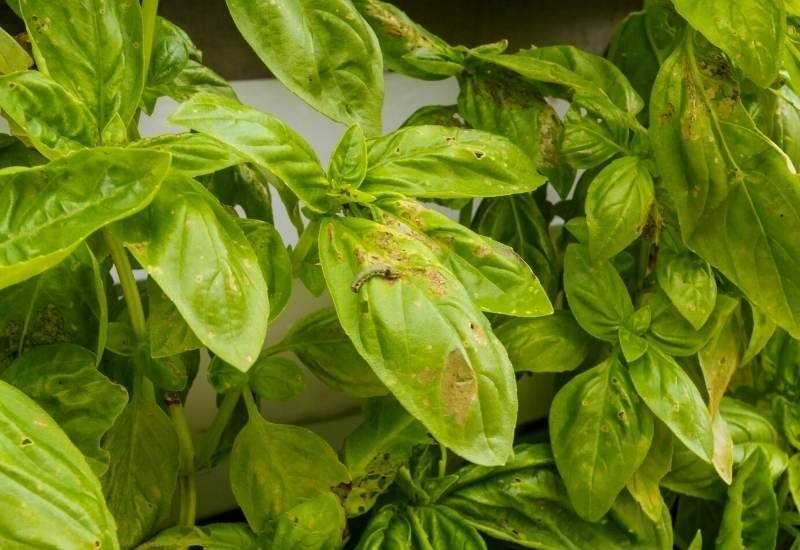
Despite its strong aroma, basil can still attract annoying pests. Pest damage may begin as simple holes, but the areas of damaged plant tissue eventually begin to die and cause browning.
Fortunately, identifying basil pests is usually simple and there are plenty of organic control options.
Aphids

Aphids are little sap-sucking insects that you may have also found on kale, cabbage, tomatoes, and other garden plants.
Their bodies are white, soft, and oval-shaped. The telltale sign of aphids is a black sticky sap on the leaves or curled, spotted leaves and stunted growth.
This is because aphids are sucking the sugars out of the plant and leaving a sticky substance behind.
Insecticidal soaps and neem oil are great options for getting rid of aphids. It’s best to wait at least a week to harvest and eat basil again after applying any sprays, and be sure to wash it thoroughly.
It also helps to plant insectary strips of white alyssum or flowering dill to attract ladybugs and other beneficial predators that eat aphids.
Slugs
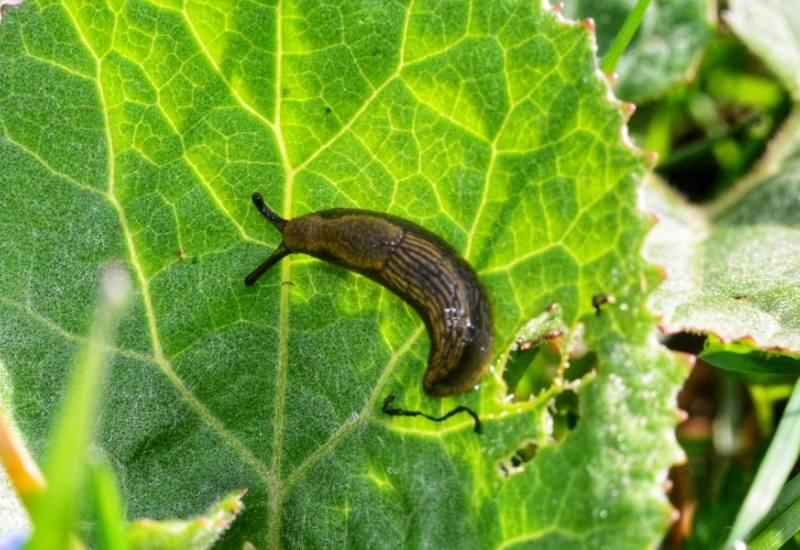
Slugs are another annoying basil problem that tends to appear in excessively moist conditions.
They leave gross slime trails and medium-sized jagged holes that could turn brown or become bleached out spots on the basil plant surface. Damage is usually on the lowest parts of the plants first.
The easiest way to get rid of slugs is with crushed eggshells or diatomaceous earth spread at the base of the plant.
These microscopically sharp edges kill the slugs by dehydrating their slimy bodies. You can also use beer traps (a shallow container of beer placed level with the soil surface) or cardboard traps (lay down cardboard overnight and pull up in the morning to kill accumulated slugs). Products like Sluggo also do the trick.
To prevent slugs in your garden, improve air circulation, avoid overwatering, and don’t mulch too closely to basil plants. This will ensure that slugs have less dark, moist places to hide.
Environmental Factors that Cause Browning
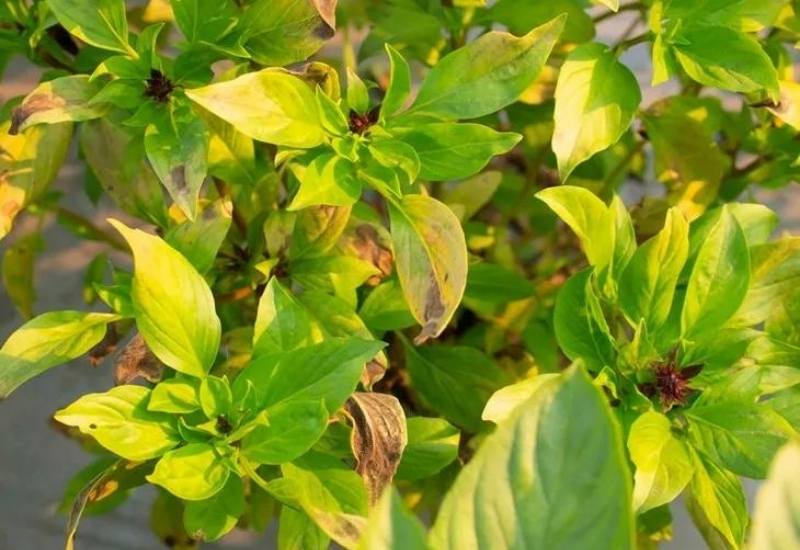
If you don’t think your basil has a disease and you don’t notice any telltale signs of pest issues, the browning leaves could be caused by a cultural or environmental issue.
1: Frost Damage
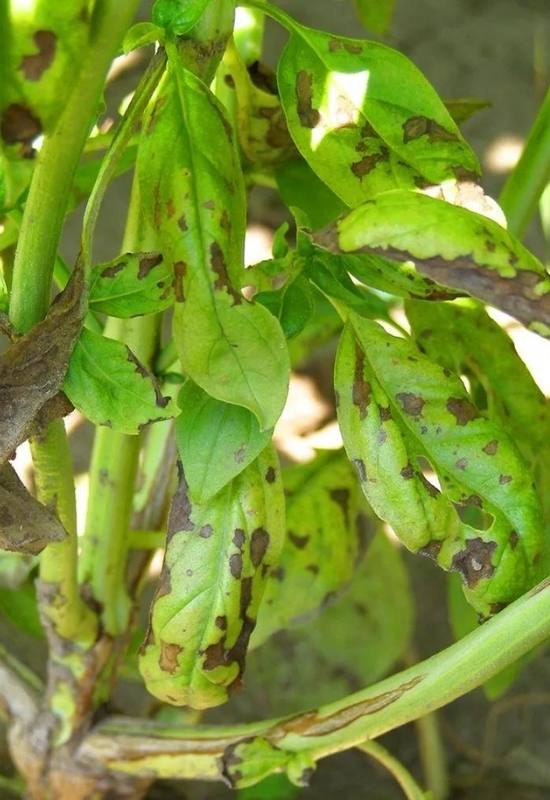
One of the most common reasons for browning areas of the basil plant leaves is early or late cold snaps.
Basil is a warm-weather crop that is very sensitive to cold temperatures. Vulnerable young leaves at the top of the plant will often darken and die off if they are exposed to temperatures below 35°F.
Frost-damaged browning leaves can be removed and the plant can be revitalized by buffering against temperature extremes.
If you want to prevent yellowing and browning of leaves due to temperature swings, you can cover your basil plants with a garden cloche, frost tent, or row cover.
It is also best to grow basil only during the spring and summer seasons unless it is protected by a greenhouse or low tunnel.
2: Nutrient Deficiency
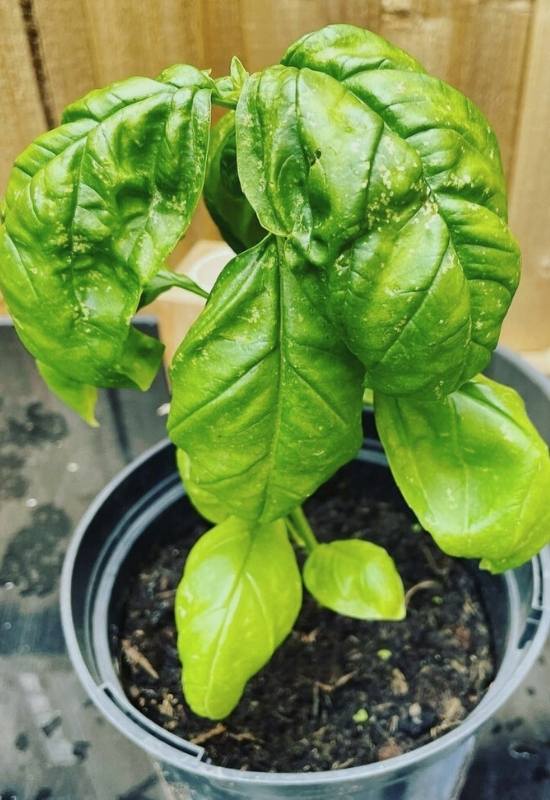
Nutrient deficiency isn’t a super common reason for brown spots on basil leaves, but once you’ve ruled out other pathogens it may be worth looking into.
Potassium and magnesium are the most common nutrient deficiencies in basil. They cause chlorotic regions (yellow or brown areas) on the leaves between the veins.
Older leaves will be affected first and often the veins themselves will stay green.
Applying fertility tends to help remedy this issue fairly quickly. Greensand and kelp meal are excellent organic options for potassium, and epsom salts (magnesium sulfate) or rich organic compost can help fix any magnesium issues.
Basil prefers rich, well-drained soil that has plenty of organic matter such as compost or decomposed manure.
3: Sunburn
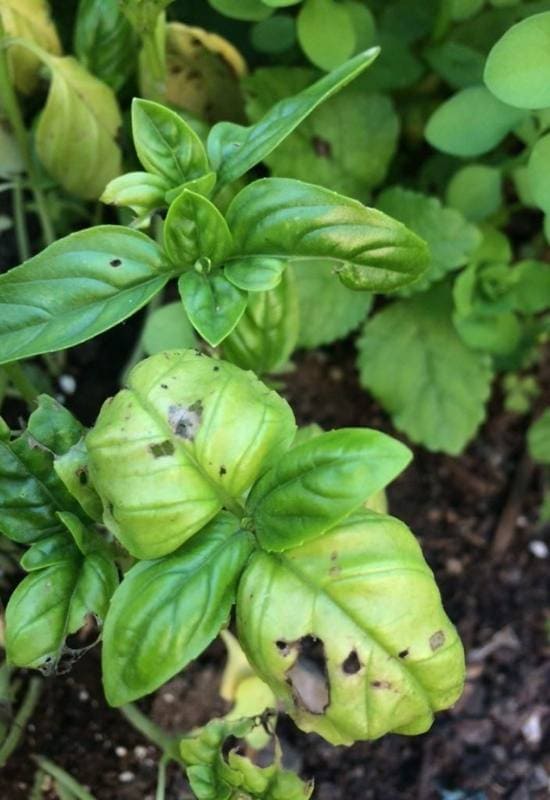
Though it loves sunshine and heat, basil is still susceptible to sunburn. The most common cause of sunburn is water sitting on the leaves and attracting harsh light like a magnifying glass.
This is yet another reason why it’s so important to only water basil from the base and avoid overhead irrigation.
Sunburn may look like bleached out or brown dead spots on the top of leaves. To prevent this issue,
only water basil in the morning or evening to avoid parts of the day when the sun is shining super bright.
You can also use shade cloth if the sun is especially intense, such as in southern regions.
How to Prevent Basil Browning
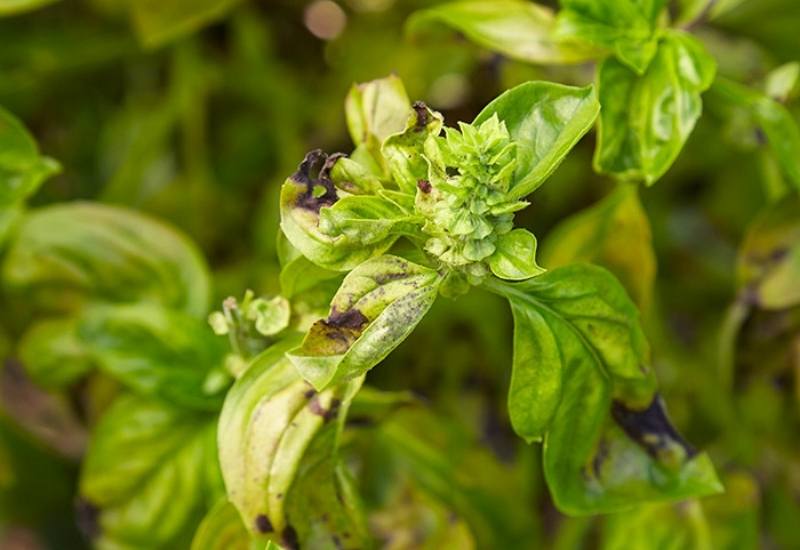
As you can see, brown or black spots on basil can have a myriad of different causes. The universal trick to preventing damage to basil plants is keeping them healthy to begin with! You can do this by:
Final Thoughts
Unsightly damage to your herbs reduces your garden yields and may affect the edibility of the crop.
While prevention is key, sometimes you realize that something is wrong when it is too late.
At that point, identifying the cause and taking quick action to remove or remedy the issue is the best course of action.
Though many basil diseases don’t have any super effective fungicides, you can still save some plants by removing the infected areas and fixing environmental issues to keep remaining basil crops happier.
At the end of the day, brown spots aren’t usually a huge deal. Basil is resilient under the right conditions and will probably bounce back with a little tender love and care.
Worst case scenario, you can always re-plant this fast growing herb and move it indoors to keep harvesting into the cooler months.
Happy gardening!

Written By
Amber Noyes
Amber Noyes was born and raised in a suburban California town, San Mateo. She holds a master’s degree in horticulture from the University of California as well as a BS in Biology from the University of San Francisco. With experience working on an organic farm, water conservation research, farmers’ markets, and plant nursery, she understands what makes plants thrive and how we can better understand the connection between microclimate and plant health. When she’s not on the land, Amber loves informing people of new ideas/things related to gardening, especially organic gardening, houseplants, and growing plants in a small space.

Can you get brownspots from too much fertilizer?
Yes, it is possible to get brown spots on basil leaves from excessive fertilizer. Overfertilization can lead to a condition known as fertilizer burn, where the concentration of salts in the soil becomes too high for the plant to handle. This can cause damage to the plant’s roots and interfere with its ability to absorb water and nutrients properly.
When basil plants are exposed to high levels of fertilizer, especially if it’s a concentrated form or if it’s applied too frequently, it can result in leaf discoloration and damage. Brown spots may appear on the leaves, and the overall health and vigor of the plant can decline.